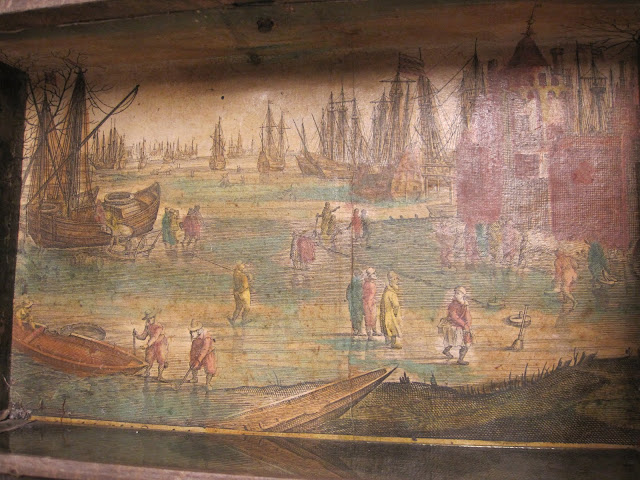
This tortoise shell edged casket didn't appear at first like it would hold a major discovery as I was looking at the sides and the interior. The interior may have had some embroidery added to it later as it is out of character. But as I progressed opening drawers and taking things out, I noted first that the pounce pots and ink wells had numbers on the bottom. That was quite exciting as it added to my growing database of sizing numbers. I believe that as the casket finishers were putting them together they had to make the sizes to fit pre-made items such as the bottles and pounce pots. So they make them for a 3, 4, 5 or 6 - all numbers I have found on the bottom of these items. They are evidence of a coordinated manufacturing infrastructure that would have been localized in one area to feed this casket obsession and turns on the head the idea that they were being made in towns all over the country.
 |
| Bottom of the ink wells with the size number on them |
As we looked inside the lid, I noted that the cavity was actually a tray and would be able to be pulled out - and it did! What I wasn't expecting was that it was lined with a print and not with plain silk! When I find prints, I get very excited as their are often clues on them to the print maker/seller or artist. So far while I know that almost all of them were sold by Robert Walton or John Overton, printmakers of the day, I haven't yet been able to identify the actual print yet! These were low cost prints that were often stencil colored by women working for them. Very inexpensive. This one really confused me as it just screamed 'Netherlands' with its subject matter.
 |
| Interior, that is a tray as evidenced by the beveled edge. Must be complete and take it out. |
 |
| The print hiding under the tray! See the sled near the ship on the upper left. |

They were curling!!! I thought that was a Canadian sport (or Norweigian's with funny pants - sorry for the obscure reference, my electrician from This Old House is trying for the US olympic team so I have learned a lot about it during our renovation). Well - come to find out (thank you wifi at 180 mph), it was invented in Scotland and the Netherlands which were avid trading partners in the 16th and 17th century. Those are stones or wood disks with sticks out of it. Note the broom leaning against one and a person using one to melt the ice ahead of a moving one.
 |
| Original uncolored print from the British Museum. The men with the sled on the right have been cut off by mirrors in the casket. |
I was freaked out - could I find this print in histories of curling? Was it the earliest known depiction? In fact - it is one of the four earliest known of curling! It took some digging but I found it on the train. It was a Dutch print called Winter and was dated 1613-1618 published by Hendrick Laurentsz. So we have the first identified print in a casket that I know of. Now the questions multiply! Why the early date, was the plate purchased by one of the English print makers and moved to England to use (that happened in England a lot) much later? Much to be thought about now.
 |
| Colfer c. 1700. Pen and ink drawing after an engraving by Romeyn de Hooghe, 1645-1708. |
I can almost feel Anita and Ervin smiling down at me today as I write this about their little secret about our sports history inside the casket that, at first, just seemed so regular.
Tricia


You're opening up whole new inspiration and topics for motifs for your CoC stitchers! Thanks! GP
ReplyDeleteSo cool! Id be squeeing with joy at a find like this!
ReplyDeleteI sent a picture tomy girlfriend Traceey as she was part of the team that won silver for the us curling team in 08 (i think)
This is amazing!! Great research...I have always wondered about the making up of caskets. Now if I could just stumble upon info about 17th century samplers...I have a theory that they were produced at a workshop with the double running stitch and/or backstich done and the purchaser did the filling stitches. Maybe. Hmm...need proof. :)
ReplyDelete